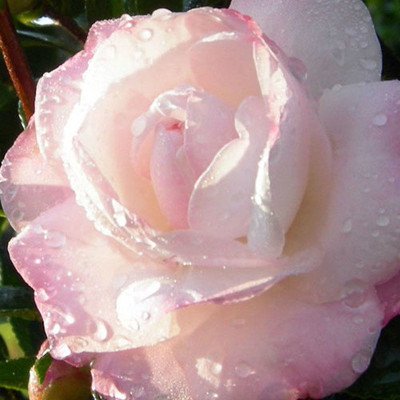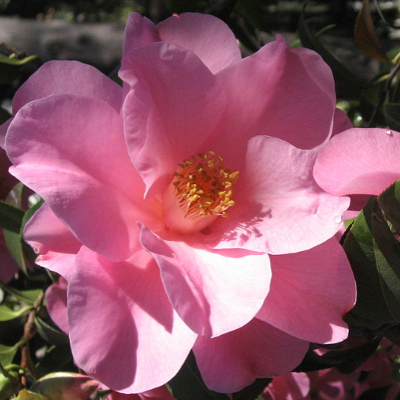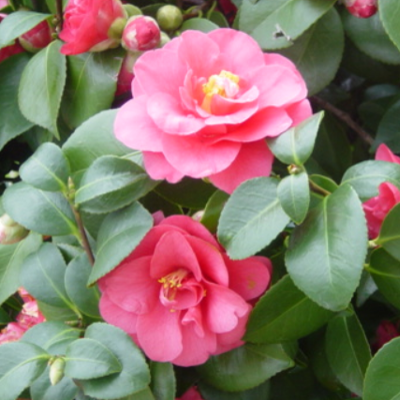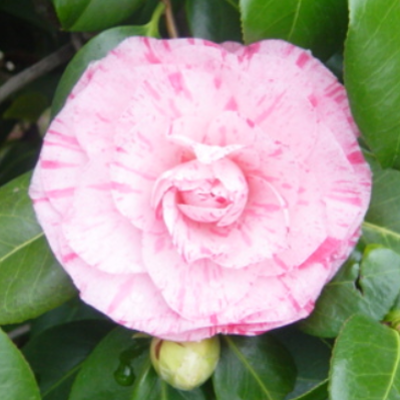Camellia is a genus of flowering plants in the family Theaceae. They are found in eastern and southern Asia, from the Himalayas east to Japan and Indonesia. There are about 20,000 named camellias in cultivation. Camellias can sometimes fool people into thinking they are roses until they get up close. They have highly glossy foliage like roses but have no thorns. And almost all of them have no scent.

There are two main types of camellias, Camellia japonica and Camellia sasanqua with a smattering of other types of camellias. Sasanquas bloom from mid fall to early winter (early to mid-season), japonicas from mid-winter to spring (mid to late season). Hybrids and other types can vary in their bloom times. When purchasing camellia shrubs, check for bloom times and for hardiness ranges. Some Japonicas will tolerate colder temperatures up to Zone 6. Sasanquas are definitely Zone 7 and south. If you live in Zone 7 and south you are able to grow a wide variety of camellias. If you live north of Zone 7 there are still some camellias you can grow too.
Main Camellia Varieties
- Camellia sasanqua
- Camellia japonica
- Camellia sinensis
- Camellia x williamsii
- Camellia reticulata
- Camellia oleifera
- Camellia chrysantha
Camellia Sasanquas - have smaller flowers but are usually much more floriferous than the Japonicas which have larger flowers but less of them on the plant. Japonicas are taller and larger plants but thrive best in shade. Sasanquas prefer sun to partial shade but are ideal for smaller lots. They tend to grow wider and lower. Sasanqua cultivars include ‘Alabama Beauty’, ‘Lisa’ and ‘Cotton Candy’. These are the most common variety of camellia grown in the United States.

Camellia japonica - also known as Japanese Camellia. These plants are evergreen and bloom in the early spring. Common cultivars include ‘Alba Plena’, ‘Debutante’ and ‘Professor Sargent”.
Camellia sinensis - or the tea camellia. It’s where we get tea leaves for that early morning cup. Tea was first cultivated in china over two thousand years ago. The story is that a Chinese emperor was tired and he was heating some water under a tree. Some of the leaves from the tree dropped into his pot. When he tasted it he discovered that it was sweet and bitter at the same time and drank it all. It left him feeling fresh and satisfied. If you like, you can grow your own tea at home! It is a beautiful plant and can be a great addition to your landscape.
Camellia x williamsii - a very floriferous hybrid ‘Water Lily’.
Camellia reticulata - a cross with the largest of camellia flowers but difficult to find ‘Rob Roy’.
Camellia oleifera - known as the oil camellia 'Lu Shan Snow'.
Camellia chrysantha - best known of the yellow camellias but very hard to find. These are not cold hardy and can only be grown in zones 11 & 12.
Different Camellia Colors
There is a large range of coloration in camellia flowers. Many have multi-colored blooms, but the most common colors of camellia flowers in American gardens is pink, red or white. You can also sometimes find other colors to grow. Most colors fall into one of these variations or a combination:
- White
- Cream
- Yellow
- Pink
- Red
- Purple
Different Camellia Flower Types
Single Camellia Flower

Semi-double Camellia Flower

Formal double Camellia Flower

Peony form Camellia Flower

If your camellia is happy where you planted it, they have been known to live 100-200 years although there are some that are even older in some of the plantations and public gardens. Some of the oldest ones in America reside at Middleton Plantation along the Ashley River in Charleston, South Carolina.
 |
Author Denise Schreiber - Published 3-22-2020 |
